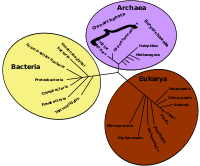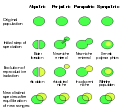Portal:Evolutionary biology
Introduction
Selected article - Evolution of sexual reproduction describes how sexually reproducing animals, plants, fungi and protists could have evolved from a common ancestor that was a single-celled eukaryotic species. Sexual reproduction is widespread in eukaryotes, though a few eukaryotic species have secondarily lost the ability to reproduce sexually, such as Bdelloidea, and some plants and animals routinely reproduce asexually (by apomixis and parthenogenesis) without entirely having lost sex. The evolution of sexual reproduction contains two related yet distinct themes: its origin and its maintenance. Bacteria and Archaea (prokaryotes) have processes that can transfer DNA from one cell to another (conjugation, transformation, and transduction), but it is unclear if these processes are evolutionarily related to sexual reproduction in Eukaryotes. In eukaryotes, true sexual reproduction by meiosis and cell fusion is thought to have arisen in the last eukaryotic common ancestor, possibly via several processes of varying success, and then to have persisted. Since hypotheses for the origin of sex are difficult to verify experimentally (outside of evolutionary computation), most current work has focused on the persistence of sexual reproduction over evolutionary time. The maintenance of sexual reproduction (specifically, of its dioecious form) by natural selection in a highly competitive world has long been one of the major mysteries of biology, since both other known mechanisms of reproduction – asexual reproduction and hermaphroditism – possess apparent advantages over it. Asexual reproduction can proceed by budding, fission, or spore formation and does not involve the union of gametes, which accordingly results in a much faster rate of reproduction compared to sexual reproduction, where 50% of offspring are males and unable to produce offspring themselves. In hermaphroditic reproduction, each of the two parent organisms required for the formation of a zygote can provide either the male or the female gamete, which leads to advantages in both size and genetic variance of a population. (Full article...)General images -The following are images from various evolutionary biology-related articles on Wikipedia.
Selected picture - The last known Thylacine photographed at Hobart (formerly Beaumaris) Zoo in 1933. A scrotal sac is not visible in this or any other of the photos or film taken, leading to the supposition that "Benjamin" was a female, but the existence of a scrotal pouch in the Thylacine makes it impossible to be certain Did you know... -
CategoriesRelated portalsTasks you can do
Related topicsWikiProjectsWikiProjects connected with biology: A complete list of scientific WikiProjects can be found here. See also Wikispecies, a Wikimedia project dedicated to classification of biological species. Associated WikimediaDiscover Wikipedia using portals |











![Image 11A covalent adduct between the metabolite of benzo[a]pyrene, the major mutagen in tobacco smoke, and DNA (from Mutation)](http://upload.wikimedia.org/wikipedia/commons/thumb/d/d8/Benzopyrene_DNA_adduct_1JDG.png/87px-Benzopyrene_DNA_adduct_1JDG.png)





































